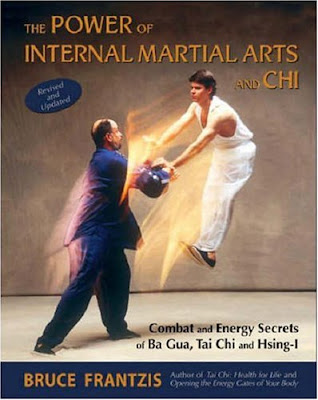Over the past few decades there has been a veritable explosion of martial arts books on the market. Perhaps in no other quarter has the impact been so great as in the topic of Chinese internal martial arts. In that genre few works can compare with Bruce Frantzis’ THE POWER OF THE INTERNAL MARTIAL ARTS and CHI.
For those unfamiliar, Bruce Frantzis is an extraordinary US martial artist who started his martial career in New York City in 1961. Around the age of 12 he began learning judo which eventually lead him to take on karate, jiu-jitsu, and aikido. Before completing his teen years, he had achieved five black belts in Japanese martial arts and had won medals in several tournaments.
In 1967 at the age of 18 he enrolled at Sophia University in Tokyo, leading his training to expand to numerous other systems, teachers, and training in journeys to China, Taiwan, Hong Kong and even India, to study yoga. During this period he was able to train for two years with Aikido's founder, Morihei Ueshiba. His experiences, particularly with Ueshiba's use of ki (chi, life energy) eventually shifted his main focus from hard style, "external" martial arts to soft style, "internal" systems. Over time this also facilitated a shift in interest from fighting to healing. Frantzis' sojourn continued through decades of training with outstanding teachers and in remarkable disciplines. It's hard to imagine a more comprehensive and authentic exploration of related Asian arts with a long list of many of the world's leading experts.
One result of the author's many years of travel and study, has been the growth of his EnergyArts.com website and its generous offering of books, videos, and training programs. A seeming keystone to all this information is Frantzis' book on the internal arts.
THE POWER OF THE INTERNAL ARTS and CHI is a unique work that doesn't teach these arts but presents an integrated, dimensional, and comprehensive portrait of them. Frantzis has great treasury to draw on, including personal experiences, anecdotes, photographs, illustrations and deep insights into the nature of these arts and the masters who have lived them. With his many rich experiences he is able to paint from a broad pallet.
Primarily, the book is about China's three, main internal arts: Tai Chi Chuan, Bagua Chan, and Hsing Yi Chuan. In presenting them, Frantzis incorporates other information to fortify his material, including his own experiences working with qigong and meditation techniques. He also provides knowledge acquired from Chinese healers and qi masters. In the second edition of the book, released in 2007, the author included a 9th chapter, THE TAO OF SPIRITUAL MARTIAL ARTS, giving the work another facet of information on these arts.
To some degree this book is autobiographical, though it goes much further, with numerous profiles of the author's most prominent teachers. He relates their bios, expertise, perspectives, opinions characteristics and abilities. Of particular consideration is the story of Frantzis' final teacher, grandmaster Liu Hung Chieh, a renowned master of Tai Chi Chuan, Bagua Chan, Hsing Yi Chuan and Taoist Meditation. Liu learned Wu Style tai chi as a student with one of the style's founders, Wu Chien Chuan.
It's with Liu that the author spent three years of intense training in Beijing. He became one of only two to become a disciple/lineage holder of Liu's teaching, a rare and privileged honor for a westerner to receive from an extraordinary Chinese master.
After decades of reading books on tai chi, chi kung, and related disciplines, I have yet to see a work of such extensive comparison and in-depth exposure on this material. Frantzis has amassed an incredible life experience and wealth of knowledge, usually unavailable to foreigners seeking to learn cherished, ancient teachings. This book could only have been written by someone who had invested his life in this pursuit and found access where normally forbidden. In a very real sense, Frantzis is an explorer and this book is somewhat of a dairy, catalog, and review of his learning and expeditions.
For any appreciation of Chinese internal martial arts and traditional healing systems, this book is a necessity. It's an eye-opening, instant classic and a treasury of esoteric understanding. It should be included in any serious library on these topics and held onto for continuous research and review. And it should also be appreciated and enjoyed for the sheer pleasure of reading about these fascinating, mysterious, and wonderful arts and the cultures from which they came.
- TaiChi_John




















